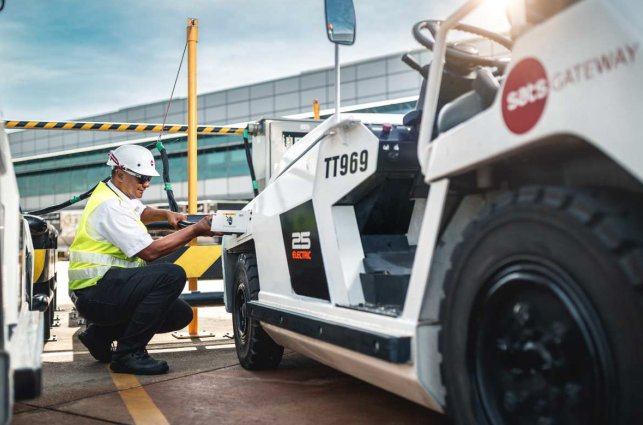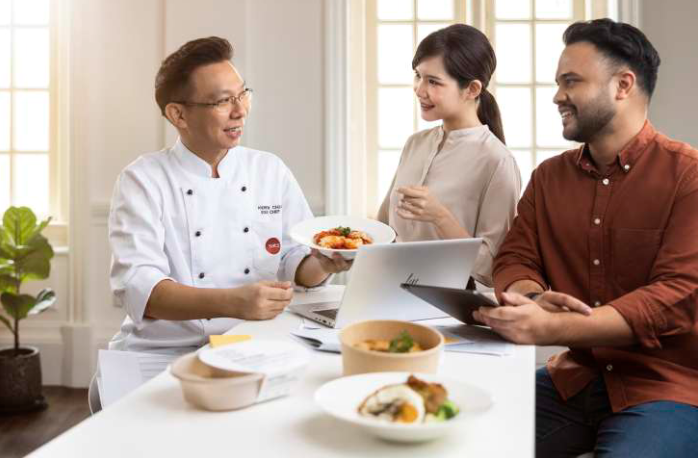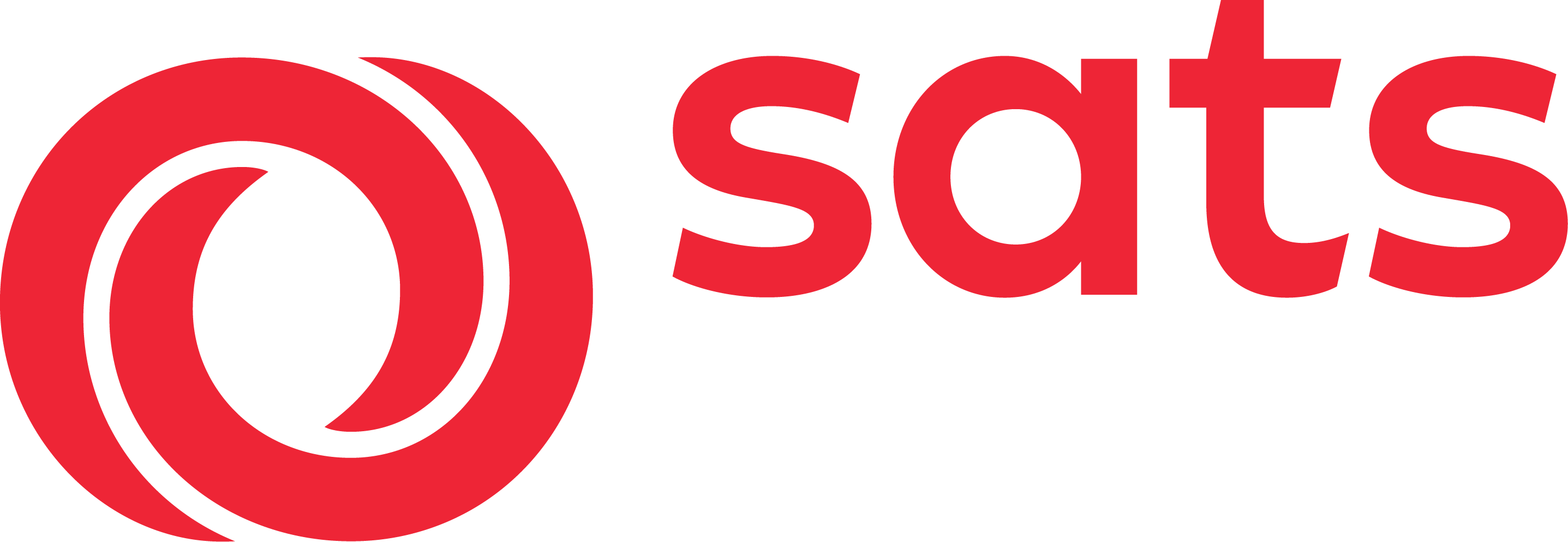In Conversation with Spencer Low
Download In Conversation with CSO (1650KB).
.png?sfvrsn=a3cf59a6_0)
As travel recovers, carbon emissions from the aviation industry is expected to rise again. What are SATS’ plans for decarbonisation?
In the last two years, we experienced an involuntary reduction in carbon emissions due to the impact of COVID-19 on the travel industry. However, SATS embeds sustainability in every aspect of our business and has remained steadfast in pursuing our ESG goals throughout the pandemic. We are structurally tackling our carbon footprint to build back better. There are many initiatives, but here are some of the key ones we have put in place to achieve that:
FY2021-22 was the first year management compensation was tied to a carbon target, namely carbon intensity for the three most significant areas of our business in Singapore — per gross meal produced, per flight handled, and per tonne of cargo handled. We have met our target for gross meal produced and exceeded our targets for flights and cargo handled, and we have set even more ambitious targets for FY2022-23.
In addition to our Scope 1 and 2 carbon emissions reporting, we have also established our Scope 3 carbon emissions for the baseline year FY2019-20 using the Quantis assessment tool, recognised by the Science Based Targets initiative (SBTi). Knowing our Scope 1, 2 and 3 carbon emissions gives us a fuller picture of our carbon footprint and enables SATS to develop a holistic plan to reduce our carbon emissions. We have established that Scope 3 carbon emissions were 836,000 tCO2e in FY2019-20, and make up 87% of our total carbon footprint for that baseline year. Purchased goods and services, in large part the agricultural products used in our food business, accounted for the biggest share at 64% of our Scope 3 emisssions. Using this analysis, SATS is looking to set meaningful science-based targets.
Continuing with our smart infrastructure initiatives, we have converted more of our GSE to electric models. SATS’ subsidiary, AAT, has installed electric vehicle (EV) charging stations at their facility in Hong Kong to reduce monthly consumption by 150 to 200 litres of petrol/vehicle. SATS’ joint venture company, AISATS, has begun converting its diesel GSE fleet to electric GSE. Throughout FY2021-22, 20 electric GSE were purchased for the Delhi, Bengaluru, and Hyderabad stations.
AISATS plans to achieve 100% conversion of light motorized GSE to electric versions by 2025.
In FY2021-22, we commissioned three new sites for solar installation, expanding our total renewable energy capacity by 5,470kilowatt-peak to a total of 9,081 kilowatt-peak. Our increased renewable energy capacity allows us to abate approximately 4,448tCO2e yearly, with more than10,000 MWh of power being generated annually. We aim to push our solarisation efforts to generate up to 15,000 MWh annually in Singapore.
SATS TFK plans to implement solar installations at our Shibayama ware wash facility near Tokyo’s Narita Airport to lower TFK’s carbon footprint. The short-term target is to increase solar energy to 5% of TFK’s overall energy mix by 2024. We also usethe Internet-of-Things (IoT) to collect data that provides a greater understanding of the energy performance of our machines in Singapore and elsewhere in our network. We are working towards incorporating data with energy consumption patterns to derive a plan for energy management to improve energy efficiency.
In addition to new installations and equipment, we have upgraded our facilities to reduce our carbon footprint. In this respect, our subsidiary, AAT, has made a significant impact and won the prestigious “Sustainable Warehouse Operator of the Year 2022” award in the Freightweek Sustainability Awards. AAT has achieved a 50% reduction in carbon footprint since2008 through the implementation of a variety of infrastructure refurbishments. These included upgrading the warehouse lighting system, changing chillers, pumps and air handling units (AHUs) to those with variable-frequency drives, and switching to electric variant for 95% of the forklifts.
Besides smart infrastructure, our subsidiary Country Foods is also leading the way for sustainable food innovation by encouraging carbon-neutral food production with the greater use of alternative proteins. Country Foods partners with alternative protein brands and food tech start-ups to tailor their product offerings for Asian palates, bringing the likes of Fable Food, First Pride, and v2food to market.

Image caption: We have converted more of our GSE to electric models in Singapore and across our network.
Earlier, you mentioned that SATS met the carbon targets tied to management compensation this year. Is this due to the lower volume of activities caused by the pandemic or the result of the decarbonisation efforts of the company?
The targets are actually set on the basis of the lower level of activities due to the pandemic and they were achieved through the various initiatives I highlighted earlier to reduce our carbon intensity.
What is SATS’ view on carbon credits?
As nations accelerate their efforts to decarbonise, demand for carbon credits will outpace supply, creating opportunities for SATS to explore waste-to-energy solutions that could also produce carbon credits. It is important to note that the SBTi definition of net-zero explicitly excludes the use of carbon credits to achieve science-based targets.
IATA supports a resolution by the aviation industry to achieve net-zero carbon emissions by 2025. The Singapore government has also announced it will achieve net-zero carbon by around mid-century. How will SATS align its decarbonisation efforts to these goals?
There are currently different definitions for net-zero, which again differ from goals such as carbon neutral or climate neutral. SATS uses SBTi’s framework, which calls for net-zero goals to encompass indirect or Scope 3 emissions. A significant mix of SATS’ business is in the food catering business, and there is as yet no scalable net-zero agricultural model. However, we are committed to working with our supply chain to make progress towards net-zero carbon emission goals.
What are some challenges impacting your decarbonisation efforts?
Some initiatives like the electrification of GSE are an ecosystem effort. We obviously have a plan for electrification but for our plan to work, we also need the support of stakeholders such as Changi Airport Group (CAG) to put in place the infrastructure needed to charge our vehicles. Another challenge is the availability of electric versions for some of our vehicles and equipment. In some cases alternatives are not yet commercially available. In other cases, the increased costs (whether in terms of capital or operating expenses) could also be a factor slowing down decarbonisation efforts. At SATS, we adopt a holistic approach towards evaluating sustainability-related initiatives. For example, the substrate used for making the sustainable packaging for Singapore Airlines’ inflight service ware may cost a little more, but we gain in other areas like haulage because biodigestion can reduce the waste by as much as 60%.
Policies and regulations are also not always clear. For example, there is a lack of clarity and alignment across governments and regulatory bodies regarding emission reduction targets. In our industry, there is the additional challenge of waste segregation. When you are served a meal on a plane, you will see different types of packaging like plastics, foil, paper, etc. For this to be made more sustainable, we will need to segregate the waste, and that is generally not feasible. Nonetheless, we are constantly working with our customers and strategic partners to develop more sustainable packaging for inflight service like the “Doodle” that is used for certain Singapore Airlines flights.
I understand SATS adopts an open collaborative platform to engage external partners to collectively develop solutions to protect our environment. Can you tell me what some of these collective actions are?
There are many solutions that we are trialing with our customers and strategic partners, but notable ones include Country Foods working on growing the alternative protein market with different start-ups. One of these is Fable which is a mushroom-based ingredient that has the texture of meat that is almost like pork. Through a collaboration with our subsidiary in UK, Monty’s, we have developed a range of products that is now sold in over 300 Marks & Spencer stores in the UK. We have also done a lot of work around waste reduction for Singapore Airlines, which has removed 80% of the plastics in the meal service. We are also developing closed-loop solutions for some of our non-travel customers by replacing disposables with rotables.

Image caption: Through a joint collaboration between Country Foods and the SATS Global Innovation Centre hubs in Singapore and the UK, the Group has connected Australian-based Fable Food to growth opportunities in Asia and beyond.
Can you give a broad overview of SATS’ commitments towards sustainability in the food industry, particularly with food waste?
One of the themes of our sustainability framework is to reduce and process food and packaging waste responsibly. For food waste specifically, our goal is to halve food wastage intensity in all operations by 2028 from our 2021 baseline.
How is the data collected stored and used for SATS’ operations and systems?
Data is being collected manually and digitally, and we endeavour to roll out more of the AI-enabled waste tracking system across our production facilities. Our operation teams glean insights from these digitally stored data, such as the type of SKUs being disposed of regularly.
![]()
Image caption: The artificial intelligence capabilities of our waste tracking system are trained to learn and recognise different types of waste and automatically record them in a database.
How are waste streams measured and monitored?
The artificial intelligence capabilitie sof our waste tracking system are trained to learn and recognise different types of waste and automatically record them in a database. Through data analytics, we can monitor the reasons for wastage, for example spoilage, expiry, or over-production, and adjust our demand planning and material sourcing accordingly.
Can you share with us the waste stream process during production?
Waste generated from our production kitchens is comprised primarily of food trimmings. Food trimmings do not have less nutritional value, but are waste generated by the cutting and meal presentation requirements. Our chefs find ways to repurpose the use of food trimmings that not only reduce waste but also allow them to hone their culinary innovation by blending certain trimmings to enrich the flavours of soups and sauces.
How much product is converted through the eco-digesters? How are these products re-channelled through SATS’ systems?
For the period January to June 2021, we have converted a monthly average of four tonnes of food waste to refuse-derived fuel (RDF) through our pilot biodigester. The RDF output can be used as fuel additives in incinerators. We work with local waste management solution providers to convert the RDF to energy. This system helps reduce the volume of waste requiring haulage by as much as 60%. We will continue to explore new technologies that can enable better circularity of waste treatment and management for our operations. For example, we are currently working on a proof-of-concept of an anaerobic digester at our catering facility.
Can you tell us more about the equipment and machines used by SATS to reduce food waste?
We can’t manage what we can’t measure. Hence, we’ve implemented an automated food waste tracking system at our in-flight catering centre using six AI-enabled machines that capture volumes of different waste streams from our production kitchens. This helps us gain greater visibility of our waste output, enabling us to identify ways to improve production efficiencies and optimise material planning. On the backend, we use a pilot biodigester to reduce the food waste treated by as much as 60% of volume.
What are the top three issues faced by the food industry?
First is food security. With increasing urbanisation and population growth, food sources are struggling to catch up with demand. There are two billion people in the world who do not have access to safe, nutritious food. Even in prosperous cities like Singapore where food availability has not been an issue, we have to increase our supply chain resilience to ensure we have safe access to food. Second is food and packaging waste. According to a 2021 UN report, 17% of food produced globally in 2019 goes to waste, with foodservice and retail accounting for 26% and 13% of this respectively. Single-use plastics are the biggest contributor to waste around the world, and food packaging is a major component. The third issue is the carbon footprint of food production. Almost a third of human-caused greenhouse gases are from the world’s agri-food system. In many countries, the food supply chain is going to overtake farming as the largest contributor of greenhouse gases.
How does SATS’ sustainability thought leadership help to bridge the gap?
Sustainability thought leadership sits with the SATS Global Innovation Centre or SGIC. There are three disciplines within the SGIC – insights ecosystem, sustainability thought leadership and design thinking. The insights ecosystem helps us to understand in depth, the markets, the channels and the consumers that we want to target. Sustainability thought leadership focuses on new and more sustainable food and packaging ideas that help position SATS as the leading authority in Asia in this area. These two capabilities help us to identify the areas where we want to innovate. We then apply design thinking as a discipline, working with our colleagues at SGIC who have the relevant expertise and supplementing this with knowledge from our business units and collaborators outside of the business. We will then focus on developing the innovative food and packaging solutions that will target the white space opportunity we have identified.

Image caption: Sustainability thought leadership focuses on new and more sustainable food and packaging ideas that help position SATS as the leading authority in Asia in this area.
How much capital expenditure have you earmarked for your ESG initiatives?
This is not done explicitly. Commitments to our ESG goals are part of our sustainable business strategy and aligned with our strategic priorities. Much of the capital expenditures for upgrading our facilities in Singapore and elsewhere have taken into consideration the benefits to the business in terms of higher energy efficiency and lower wastage. For example, we have made available sustainable packaging for food on board Singapore Airlines, which gets broken down by a biodigester, reducing the waste substantially and reducing waste haulage cost. We also replace our ground support equipment at the end of their lifecycle with electric models.
Does the board have ultimate responsibility for climate change?
Our Board has oversight of our sustainability strategy and performance, in addition to the adequacy and effectiveness of our internal control and risk management system. While the board makes certain that sustainability goals are integrated into all programmes and business imperatives, our executive management provides stewardship and ensures that our business and strategy are aligned with our sustainability goals. This is supported by the Sustainability Council set up last year, comprising sustainability champions from the business units and staff representatives across various departments and overseas subsidiaries. Since last year, we have also included carbon intensity reduction as part of management performance targets linked to remuneration. This signals our management’s commitment to tackling climate change.
In closing, what would you advise businesses that are starting on their sustainability journey?
My advice is to make sustainability central to your business. Sustainability is essential for the long-term success and survival of any business. We operate across complex supply chains involving many different parties, and engaging them on sustainability will develop collaborative advantage that will benefit every stakeholder within the ecosystem.
